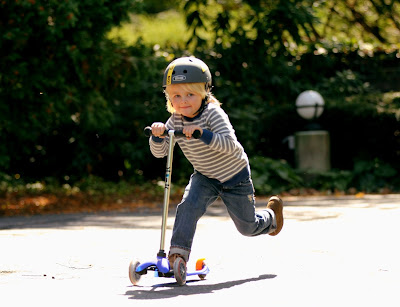Kick Scooter
Models and history

1. Early scooters
Primitive scooters have been hand-made in industrial urban areas for at least 100 years. One common homemade version is made by attaching roller skate wheel sets to a board with some kind of handle, usually an old box. You can lean to turn, or by a second board connected by a crude pivot. The construction was all-wooden, with 3–4 inch (75–100 mm) wheels with steel ball bearings. An additional advantage of this construction was loud noise, just like from a "real" vehicle. An alternative construction consists of one steel clamp–on roller skate divided into front and rear parts and attached to a wood beam.
2. Pneumatic tires
Before bicycles became popular among children, steel scooters with two small bicycle wheels had been the most useful vehicles for them. Around 1987, many BMX manufacturers produced BMX-like scooters as Scoot. Those manufacturers discontinued their scooters, but some scooter manufacturers were established after years, and still develop similar scooters today; Some are used in dense urban areas for utility purposes, being faster than a folding scooter and more convenient than a utility bicycle. Some are made for off-road use and are described as Mountain Scooters. Besides commuting, sports competition and off-road use, large wheel scooters are a favorite for Dog scootering where single or team dogs such as huskies pull a scooter and rider in the same way that a sled is pulled across snow. Some amish are not allowed to ride bicycles, so they ride scooters instead Today variations on the kicksled with scooter design features are also available, such as the Kickspark.
3. Folding scooters
In 1996, a foldable aluminium scooter with inline skates wheels was created by Wim Ouboter of Micro Mobility Systems in Switzerland The scooter was sold as "Micro Skate Scooter", "Razor" and "JDBUG/JDRAZOR MS-130A". After the Razor was introduced to Japan in 1999, many young people in Tokyo began to use it as a portable transporter then it became a fad around the world, and such small scooters also became popular toys for children.
Due to the light weight, a new sport "freestyle scootering" was also born from the folding scooter. Today unfoldable professional scooters are produced by many manufacturers.
4. Three wheels
Three-wheeled scooters like tricycles have been produced for little children.
In 1999, Micro Mobility Systems and K2 produced a reverse-three-wheeled scooter as "Kickboard". Micro also produced the Kickboard-like-children's scooters as "Mini Micro" and "Maxi Micro". The reverse design inherently provides greater stability than the standard: a standing person will tend to stand at the front of a scooter rather than at the back. However, the steering geometry is inherently weak & requires innovative solutions to provide a decent response. An example is the MiniMicro, which uses a spring-loaded system to translate lateral force on the handbars (child leaning) into turning motion on the wheels, referred by the makers as 'lean and steer'.
5. Four wheels
The early scooters, which were made with roller skates, were four-wheeled like skateboards.
Around 2000, A Swiss company produced a four-wheeled scooter as "Wetzer Stickboard". The Stickboard was a narrow skateboard with a foldable pole on the nose.
In 2006, a company called Nextsport started producing a line of four-wheeled scooters, known as Fuzion s. Fuzion scooters are typically bigger and heavier than Razor and Micro models. The early Fuzion models come with large, wide wheels, and an oversized deck for carving stability. Later scooters, such as the Fuzion NX, include smaller, harder wheels, and 360 degree handlebar spinning capabilities, unlike its predecessors.
There are also a few instances of freestyle scooter riders mounting skateboard trucks to standard aluminum style scooters to make four-wheelers.


0 comments:
Post a Comment